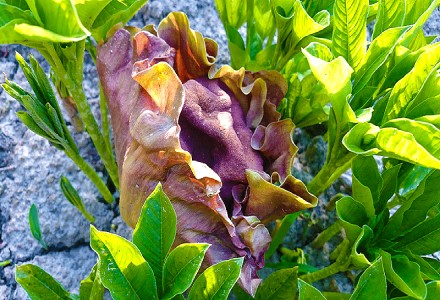
Elephant Yam Facts
- Above all, the surprising Elephant Foot Yam ranks as perhaps the most foul-smelling of all known food crops. Yet despite its powerful aroma, considered putrid by most, it is a popular food crop in some regions of the world. However, its area of distribution remains limited and continues to shrink for various reasons including habitat loss and climate change.
- In addition to its edibility, if one can get past the aroma, parts of the plant possess numerous medicinal applications. In India, it still remains popular in all three of the major medical systems: Siddha, Ayurveda, and Unani. Unlike most plants useful in both cuisine and medicine, the same part, in this case, the corm, serves both functions.
- The exact origin of the common name for the Elephant Foot Yam remains a mystery, yet many people believe it derives from its sheer size. The corm forms the edible portion of the plant and may weigh as much as 55 lb (25 kg). The corm itself grows underground, leaving only the leaves, berries, and the unpleasant smelling inflorescence above the ground.
Related Articles
Buddhas Hand Pineapple Dragon Fruit
Photographer: Anupam29feb
CC License: https://bit.ly/3fdrxLW
Elephant Foot Yam Physical Description
While opinions vary, the edible portion of the Elephant Foot Yam may be the largest and heaviest of any plant on earth. The subterranean growing corm averages 19.8 lb (9 kg). However, some specimens weigh nearly 3 times as much.
Furthermore, the astounding species also ranks as unusual for yet another reason that comes as a surprise to many. That’s because the species, which holds the classification as an herb, may grow as either an annual, a biennial, or a perennial.
The leaves of the Elephant Foot Yam grow to a length of only 20 in (50 cm) and have an ovoid shape. While the leaves grow short, the inflorescence averages a height of more than 6 ft (2 m). When ripe, the berries display a bright red color and have an ovoid shape similar to the leaves.
- Kingdom: Plantae
- Phylum: Angiosperms
- Class: Monocots
- Order: Alismatales
- Family: Araceae
- Genus: Amorphophallus
- Species: A. paeoniifolius
Photographer: കാക്കര
CC License: https://bit.ly/3j7aH2s
Elephant Foot Yam Distribution, Habitat, and Ecology
The unusual Elephant Foot Yam grows natively in a hot and highly specific range. That range includes India, Asia, Africa, and certain tropical Pacific islands. Given its range, the species evolved to inhabit a hot and wet climate.
In addition, the tropical species reproduces via the same tuber that man uses for food and medicine. However, the plant requires between 3 and 4 years before the corm develops enough to be either consumed or used for medicine.
Further, its use as a food crop varies by region. But, the most common methods of consumption include boiling and frying. Its medicinal uses also vary by region but include treatments for various forms of respiratory distress.
Finally, various chemical compounds in the Elephant Foot Yam also show promise for treating a wide range of other ailments. These include dysentery, joint inflammation, and abdominal pain. Research also continues into other possible uses.
Species Sharing Its Range
Green Dragontail Caracal Spiny Bush Viper
Check out our other articles on 5 Marvels of New Zealand and Australia, Northern Bald Ibis, Bay of Islands, Turnip Moth, White Beaked Dolphin, Lumpfish, Gharial, Oilbird

